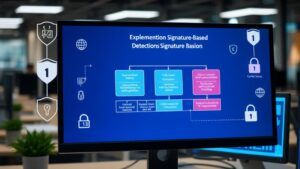How Can Signature-Based Detection Enhance Your Cybersecurity?
To effectively use signature-based detection, start by gathering threat intelligence on known malware signatures. Next, choose detection tools that integrate seamlessly with your existing security framework.
Regularly update and define signatures to encompass a wide range of threats.
Continuously monitor your systems for anomalies while validating detection mechanisms. Fine-tune your settings to balance sensitivity and specificity, which minimizes false positives yet ensures critical alerts aren’t missed.
Regularly assess and adjust your approach based on the evolving threat landscape.
By following these steps, you’ll enhance your organization’s security capabilities and stay ahead of potential threats.
Key Takeaways:
- Regularly update malware signatures to improve detection accuracy.
- Integrate with other methods to cover zero-day vulnerabilities.
- Optimize detection settings for minimal false positives.
- Continuously monitor and adjust based on the evolving threat landscape.
- Select compatible tools for smooth integration into your security framework.
Understanding How to Use Signature-Based Detection

When it comes to cybersecurity, many professionals rely on signature-based detection as a fundamental method for identifying threats. This approach hinges on recognizing specific patterns, or signatures, associated with known malicious entities. Signature types can vary, including file hashes, byte sequences, and even specific behaviors exhibited by malware. By cataloging these signatures, you can create a comprehensive database that aids in swiftly identifying threats.
Detection accuracy is paramount in this method, as it determines how effectively your system can discern between legitimate and malicious activities. While signature-based detection excels at identifying known threats, it struggles with zero-day vulnerabilities and polymorphic malware that alter their signatures to evade detection. Therefore, understanding the limitations of signature types is crucial.
You shouldn’t rely solely on this method; instead, consider integrating it with other detection techniques, such as behavior-based or anomaly detection. By doing so, you enhance your overall security posture, enabling your systems to adapt to evolving threats.
A balanced approach ensures that you maintain high detection accuracy while addressing the inherent weaknesses in a purely signature-based framework.
Why Use Signature-Based Detection for Malware Protection?

One of the primary benefits of signature-based detection is its ability to deliver high accuracy in identifying known threats, making it a reliable choice for many cybersecurity systems. By leveraging established malware signatures, you can effectively classify and neutralize threats that have been previously documented.
This method excels in several key areas:
- Quick Malware Identification: Signature-based detection can swiftly identify known malware, reducing the response time to potential threats.
- Efficient Threat Classification: It categorizes threats effectively, allowing your security systems to prioritize responses based on the severity and type of malware.
- Low False Positives: Since it relies on exact matches to known signatures, the likelihood of false alarms is significantly reduced, enhancing operational efficiency.
- Resource Optimization: This approach often requires fewer computational resources compared to heuristic or behavioral detection methods, making it suitable for environments with limited processing power.
How Does Signature-Based Detection Identify Threats?

Signature-based detection operates by comparing files or data packets against a database of known malware signatures, which are unique strings of data that represent specific malicious entities. This method relies heavily on a comprehensive library of signatures to identify threats. When a file is scanned, the system checks for matches with these signatures, enabling immediate recognition of known malware.
While signature-based detection is effective, it doesn’t account for new or modified threats. That’s where anomaly detection and heuristic analysis come into play. Anomaly detection helps identify unusual patterns that might indicate a security breach, while heuristic analysis uses rules and algorithms to evaluate the behavior of files, catching unknown threats.
Here’s a brief overview of the two methods:
| Method | Purpose |
|---|---|
| Signature-Based | Detects known malware |
| Anomaly Detection | Identifies deviations from normal |
| Heuristic Analysis | Analyzes behavior for threats |
| Combination Use | Enhances overall detection |
| Limitations | May miss new variants |
Incorporating these methods alongside signature-based detection can create a more robust security framework, effectively addressing the limitations of relying solely on signatures.
What Are the Steps to Implement Signature-Based Detection?

To effectively implement signature-based detection, you’ll need to follow a systematic approach that ensures comprehensive coverage against known threats. This method relies on the identification of specific patterns associated with malware and other malicious activity.
Here’s a step-by-step guide to help you through the process:
- Gather Threat Intelligence: Start by collecting relevant data on known threats, including malware signatures and behavioral patterns. This information is essential for creating an effective detection mechanism.
- Select Detection Tools: Choose appropriate software solutions that support signature-based detection. Ensure they’re capable of integrating with your existing security infrastructure.
- Define Signatures: Develop or update your signatures based on the threat intelligence gathered. Ensure they cover a broad range of known threats, enhancing your detection capabilities.
- Monitor and Test: Continuously monitor your systems for anomalies and test your detection mechanisms against known threats to validate their effectiveness. Adjust signatures as necessary based on the evolving threat landscape.
What Are Common Challenges in Signature-Based Detection?

Encountering common challenges in signature-based detection can hinder your organization’s cybersecurity efforts. These obstacles often stem from the rapidly evolving nature of threats, leading to issues like false positives and detection latency. Addressing these challenges requires effective signature management and resource allocation to enhance your detection scope.
| Challenge | Solution |
|---|---|
| False Positives | Implement tuning techniques to reduce noise and improve accuracy. |
| Detection Latency | Optimize your systems for faster response times and real-time analysis. |
| Signature Management | Regularly update signatures to keep pace with threat evolution. |
| Resource Allocation | Prioritize critical assets and allocate resources accordingly to ensure comprehensive coverage. |
How to Optimize Signature-Based Detection for Maximum Efficiency?

To enhance the effectiveness of signature-based detection, you need to regularly update your signatures to stay ahead of emerging threats.
Additionally, optimizing your detection settings will help improve accuracy and reduce false positives, ensuring that your system operates efficiently.
Regularly Update Signatures
Regularly updating signatures is crucial for maintaining effective detection systems. Without timely updates, your signature management strategy might falter, leaving your network vulnerable to emerging threats.
To enhance your update frequency, consider the following best practices:
- Establish a schedule: Set a regular cadence for updates, whether daily, weekly, or bi-weekly, depending on your environment’s risk profile.
- Monitor threat intelligence: Stay informed about the latest vulnerabilities and threats within your industry. Integrating threat intelligence feeds can help you prioritize necessary updates.
- Automate the process: Use tools to automate signature updates. This reduces the risk of human error and ensures timely implementation of new signatures.
- Test updates before deployment: Before fully integrating new signatures, conduct testing in a controlled environment. This helps prevent potential disruptions to your operational systems.
Optimize Detection Settings
After ensuring your signatures are up-to-date, the next step involves fine-tuning your detection settings to maximize their effectiveness.
Start by adjusting your detection thresholds to balance sensitivity and specificity. If the thresholds are too low, you risk generating false positives, which can overwhelm your team and obscure real threats. Conversely, if they’re too high, you might miss critical alerts.
Next, evaluate your signature sources. Different sources provide varying levels of threat intelligence. Relying solely on one source can leave gaps in your coverage. Integrate multiple sources, including open-source intelligence and commercial threat feeds, to enhance your detection capabilities.
Consider the environment where your detection system operates. Tailor settings based on your organization’s unique risk profile, operational requirements, and the types of data you’re protecting.
Regularly review and adjust these settings in response to evolving threats and changes in your network.
Why Signature-Based Detection is Vital for Modern Cybersecurity
In conclusion, implementing signature-based detection is crucial for maintaining robust security protocols. Did you know that 95% of known malware can be effectively identified using this method? By leveraging the power of signature-based detection, you can significantly enhance your threat response times and reduce potential damage. Stay proactive in updating your signatures and refining your processes to ensure optimal performance. Embrace this effective strategy to safeguard your digital environment against evolving threats.
Frequently Asked Questions
What is signature-based detection?
Signature-based detection identifies threats by matching them with a database of known malware patterns.
How effective is signature-based detection against zero-day threats?
It’s less effective against zero-day threats, as these often lack predefined signatures and may evade detection.
Why is regular updating of signatures important?
Regular updates ensure the detection system can recognize and block newly identified malware.
How can false positives be minimized in signature-based detection?
Tuning detection settings and incorporating other methods, like behavior-based detection, helps reduce false positives.
What are common challenges in signature-based detection?
Key challenges include high false positives, detection latency, and resource allocation for updates and monitoring.
Should signature-based detection be used alone?
No, combining it with anomaly or behavior-based detection offers better coverage against sophisticated threats.

Experienced cybersecurity analyst, software engineer, patent attorney, worked with Linux, Windows, AWS, lots of security tools. Hope to help people do the right things and do the things right!


